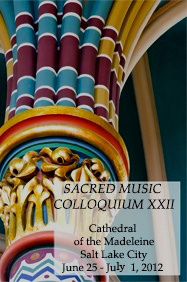The credit belongs entirely to Jeffrey Ostrowski who shepherded from the beginning. The goal was to do something, anything, to convey to the world just how exciting and thrilling the world of sacred music truly is. It was also designed to advertise and market the Sacred Music Colloquium (which this year runs June 25 through July 1 in Salt Lake City).
It seems odd to use the language of marketing here since no one makes a dime from this event and the sponsoring organization runs on a shoestring budget. If it were not for periodic (but rare) benefactors that picked up some of the bills, we would have shut down long ago. The truth is, that everything needs marketing at some level, something to convince people to interrupt the regular course of their lives and try something completely new.
This has been the great challenge in the world of sacred music. The problem in our parishes is not unknown. It goes something like this. Our music is not serious, not substantial, not liturgical, facts which drive off serious people and talented musicians; but without the serious people and talented musicians around, there is no real hope for improvement down the line. It becomes a vicious circle that digs a deeper hole every year.
This happened only recently to a top-notch musician who moved to a college town. She went to a local parish to offer services. Then she found something amazing. The parish was large but had no musicians at all. There was no budget and no talent. They scraped by on the usual terrible music from the 1970s, sort of singing and sort of playing a few things. But otherwise there was nothing.
She began to ask around as to why this was so. The answer came quickly. No musicians are involved because the music is so bad. And the music is so bad because no musicians are involved. How do you break out of such a disaster? And by the way, this is not at all uncommon. Musicians have been fleeing the Catholic world for decades, and only recently started to return very slowly.
The only way out is find people who have an ever so slight interest in doing something about the problem, training them to read and sing the chants of the faith, and inspire them to get to work in saving the liturgy and the world. It’s not so easy to do this. You have to inspire even that much interest. You have to get people to believe that it is worth their time and effort. And, let’s face it, Catholics aren’t much for making serious commitments beyond weekly Mass attendance. They imagine themselves to be consumers not producers of services. It is pathetic but true, and I wish I understood why.
Still, we have to offer opportunities for those who feel the call. If we do not, there is no hope at all for change.
The Colloquium goes many steps beyond that toward total immersion in heavenly beauty for a full week. Yes it is life changing. Every year the Colloquium has attracted more people. This year will be the biggest and best ever. I would suggest that nearly all progress in the Catholic musical arts in this country and beyond are due to this one event.
The really big change this year is that we have opened up the program on both ends: you can be a non-musician, non-singer, and not read a note, or you can be an advanced professional with a conservatory degree. Absolutely everyone can benefit. We wanted to reduce the intimidation element that keeps people away while always increase professional networking opportunities. We hope that we’ve done both.
It is an uphill struggle and it is certainly not lucrative. But here we are with the job that has fallen to this generation. We must rebuild. We must work. We must leave Catholic tradition for others to pick up and appreciate in the next generation. If we do not, we have not fulfilled our mandate.
It only takes one generation to make this turnaround happen. With enough commitment and sacrifice, it can happen. It also involves non-musicians. We need donors. We need attendees. We need people to talk this up. We really need prayers.
There have been dark times in the past for sacred music. But the light can come if we take the right steps. Please join us.

